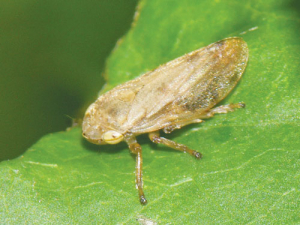Plant & Food Research (PFR) invested $4.3M in wine science research from the MBIE Strategic Science Investment Fund.
Part of this investment goes to the Vineyard Health programme, which focuses on maintaining healthy vineyards unburdened by pests or pathogens.
Why/Background/Issue
Xylella fastidiosa (Xf) - the bacterial cause of Pierce’s Disease (PD) – is a priority incursion risk for NZW. PD is fatal to infected vines, and with no cure, would pose a significant threat to New Zealand’s wine industry. The estimated cost of PD to grape growers in California alone is US$104.4M per annum. This does not even include the substantial costs of preventive measures against the spread of vectors (insects) within vineyards.
Glassy Winged Sharpshooter (GWSS) is considered the primary vector of Xf on grapevines, but the recent outbreak of Xf devastating olive groves in Southern Italy highlighted that Xf has a broad host range and that “all xylem fluid-feeding insects must be considered to be potential vectors”. New Zealand has no record of Xf, or GWSS, but dispersal of Xf within New Zealand, if accidently introduced, could occur through other vectors. For example, the meadow spittlebug (Philaenus spumarius) is common in New Zealand and is an Xf vector. New Zealand imports large quantities of potentially Xf-harbouring host plants, including cut flowers and nursery stock. Plants harbouring Xf can remain symptomless for a long time, and rapid and accurate detection can be difficult.
This project is helping to create a state of readiness for a PD incursion, by identifying the presence, distribution, host range and ability to feed on grapevine varieties, of potential Xf vectors already present in New Zealand vineyards.
It will also validate the diagnostic testing protocols for detection of Xf in vectors, enabling a more rapid response to any incursion. Improved risk assessments, detection technologies and optimized surveillance will all lead to better preparedness and risk mitigation. Furthermore, this knowledge will improve pest management in vineyards, and thus enhance the resilience of these productive ecosystems.
No work has previously been carried out on Xf or PD vectors in New Zealand. What we learn will be relevant to numerous other sectors (crops, forestry) too, because of Xf’s wide host range.
What we did in the first year
Surveyed areas in Auckland, Port of Tauranga, Hawke’s Bay, Marlborough, North Canterbury and Central Otago, and collected populations of any xylem feeders found.
Established laboratory colonies of these insects
Quantified the feeding activities on grapes of identified species using an electrical penetration graph (EPG)
Lodge applications with EPA for a new organism approval and with MPI for an import permit and CTO approval to bring cultured Xf into PC3 containments for future transmission studies
What we found
Potential insect vector species of Xf were found in vineyards across New Zealand.
The research found that meadow spittlebug has a wide distribution in and around our grape growing districts. This is of great concern because of its abilities both to vector Xf (overseas data) and, as demonstrated in this study, to feed successfully on grapevines. A
lthough other types of spittlebugs were found, they were not widespread in vineyards and did not feed as much on grapevines, but they may still play a significant role if they are able to vector Xf.
All potential spittlebug Xf-vectors found could feed on New Zealand’s most important grapevine variety: Sauvignon Blanc; indeed, Sauvignon Blanc could be a preferred food plant for them.
These insects also have a wide host range and can survive on grapevines without the presence of green leaf material, with numerous alternative plant hosts found within vineyards year round.
Beside spittlebugs, only one other obligate xylem-feeder insect was found in this study: a single adult cicada. There are 42 cicada species unique to New Zealand, found in a variety of habitats, including tall forest, scrub and grassland. Considering the large amount of grass in and around vineyards, a dedicated study using sampling techniques specific for cicadas might have caught more. However, in light of our survey results and the still-tentative role of cicadas as Xf vectors, this was not pursued further.
This survey represents only a snapshot in time during the grapevine-growing season; both the recorded species and other spittlebug species may be found in and around the vineyards if surveyed at different times of the year.
For example, C. fingens was only trapped around Auckland, however, previous records show that adults of this species have been recorded during spring, summer and autumn in coastal areas from Northland to Nelson on numerous host plants. Carystoterpa vagans was not identified during the survey although this species is widespread in New Zealand and also found on numerous host plants from spring till autumn. In addition, Xf transmission efficacy varies substantially depending on insect species, and spittlebugs may show high efficacy. There is international evidence for spittlebugs being vectors of Xf and the ability of New Zealand species to acquire and transmit Xf will be determined in upcoming work.
So far, we have shown that spittlebugs in New Zealand may be important vectors of Xf, if Xf were accidently introduced. For biosecurity readiness for PD in grapes, we need to understand their association with Xf, potential host range, geographical distribution, and the potential for effective management and control of these species.
We will continue this project for another two seasons.












